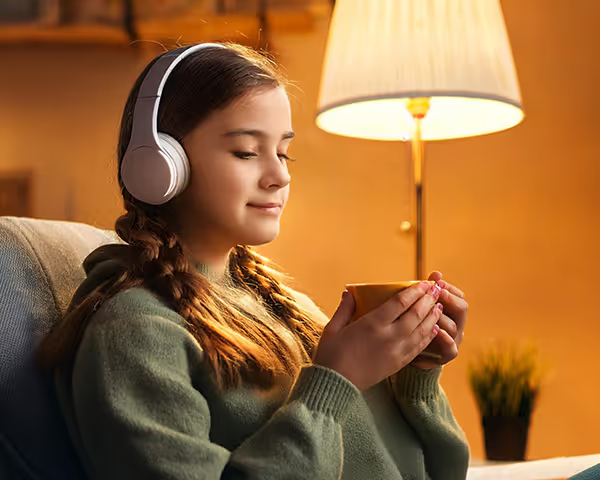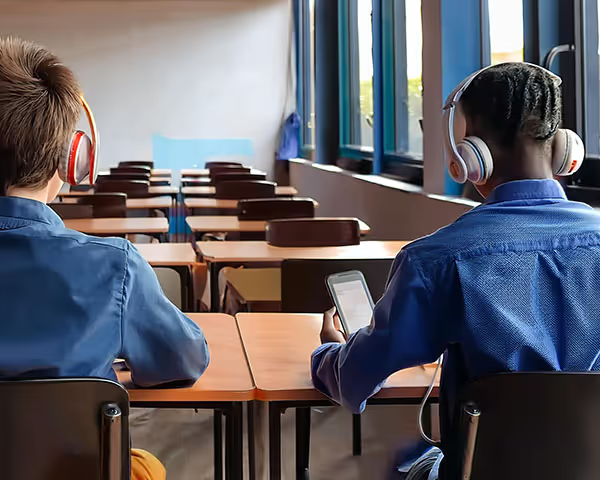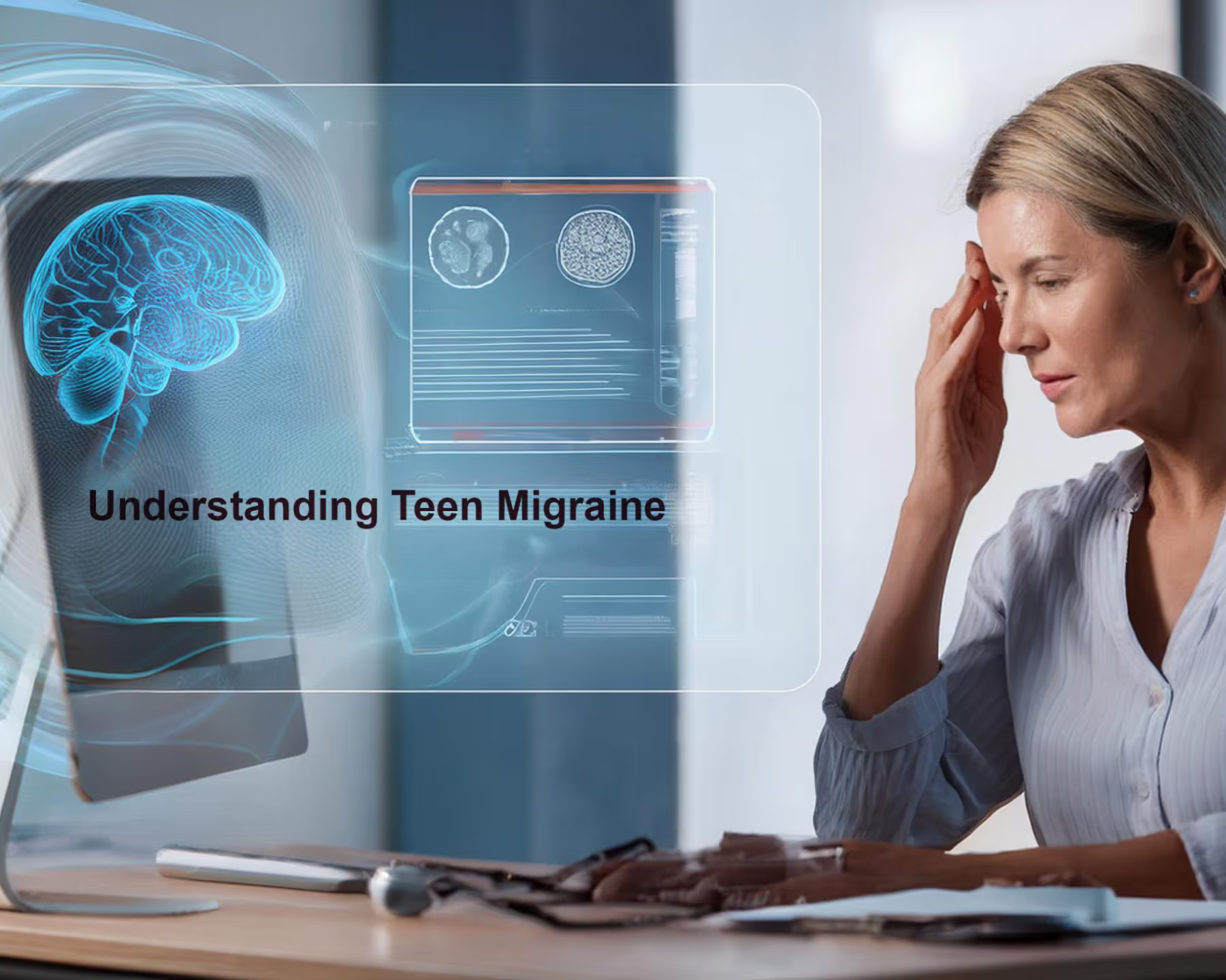Teenagers
& Parents
How to Spot the Symptoms of a Teenager’s Migraine
Many of the migraine symptoms teens experience are similar to those adults have. In addition to mild to severe
throbbing headaches on one side of their head or on both sides, teens may experience vomiting, nausea, sensitivity to
light or sound, or neck pain, during the time of the headache.
Some teens may experience aura before the headache strikes (Aura Phase), including visual disturbances, like seeing
flashes of lights or zigzags. They may also feel a tingling sensation in their body [3].
Not all adolesents experience aura.Head pain may follow warning signs (Prodrome Phase) like neck stiffness, fatigue,
sensitivity to light, sensitivity to sound, irritability, mood swings. Other warning signs may include cognitive
impairment, sensitivity to smell, nausea or vomiting, yawning, dizziness or vertigo, or food cravings [4].
Following the migraine headache (Postdrome Phase), some teens experience a hangover-like mental fog, inability to
concentrate, depressed mood or euphoric mood [5].Migraine attacks in teens are typically briefer than those in adults
[1].
Some teens experience abdominal migraine. Rather than a pain in their head, it causes a dull, itchy sensation in their
abdominal area. During an abdominal migraine, they may experience nausea, drowsiness or fatigue, loss of appetite,
vomiting, or paleness of skin.
What Causes Migraine in Teens?

Teen migraine causes can vary from person to person. For some, it may be hormone related. As hormone levels change
throughout puberty, teens, and especially teenage girls, may experience more headaches [7].
The causes of migraine in teenage girls are often hormone related. A decrease in estrogen levels a couple of days
before the beginning of a monthly period is a common cause for menstrual migraine. Causes of migraine attacks in
teenage boys might be hormone related if they have higher-than-normal estrogen levels in their bodies. Other common
causes for migraine in teens are genetic predisposition and other physiological causes [8].
Stress, dehydration, lack of sleep, skipping meals, too much caffeine, caffeine withdrawal, motion sickness, weather
changes, alcohol, or certain foods are all possible triggers that might increase the probability for a migraine
attack, and the severity of the attack [9]. Teens may also experience a migraine after consistently getting too much
screen time on phones, laptops, TV, or gaming devices.
Quick Reference for Common Causes and Triggers of Teenage Migraine
Triggers include:
Too much screen time and electronics
Stress or anxiety
Dehydration
Lack of sleep
Caffeine
Missing a meal
Motion sickness
Trigger foods
Migraine attacks are common, especially in women. If you experience migraine, please know that there is help
available. You do not need to feel alone. Talk to your doctor about creating a treatment plan that fits your symptoms
and individual needs.
Also, ask your family or close friends for support. Keep them informed of your symptoms and treatment plan so they can
encourage and help you along the way.
Latest in Teens and Parents
Get Nerivio to Treat and Prevent Migraine
Ask your doctor about drug-free migraine treatment options. Nerivio is an FDA-cleared, drug-free, wearable device
for migraine treatment and prevention that works safely and effectively by activating natural pain pathways to
inhibit migraine and associated symptoms. It is a smartphone-controlled, noninvasive wearable that is discrete and
easy to use.
Nerivio has not been clinically tested during pregnancy. Consult your healthcare provider about using Nerivio as a
dual-use therapy – for treating and preventing migraine.
Sources
- Stovner, L. J., Hagen, K., Linde, M., & et al. (2022). The global prevalence of headache: an update, with analysis of the influences of methodological factors on prevalence estimates. The Journal of Headache and Pain, 23, 34. https://doi.org/10.1186/s10194-022-01402-2
- American Migraine Foundation. (2019, March 21). Migraine Through A Woman’s Life. Retrieved from https://americanmigrainefoundation.org/resource-library/migraine-through-a-womans-life/
- Stanford Health Care. (n.d.). Headache Diary. Retrieved from https://stanfordhealthcare.org/medical-conditions/brain-and-nerves/headache/diagnosis/headache-diary.html
- The Migraine Trust. (n.d.). Stages of a migraine attack. Retrieved from https://migrainetrust.org/understand-migraine/stages-of-a-migraine-attack/
- American Migraine Foundation. (2022, August 4). Migraine Home Remedies. Retrieved from https://americanmigrainefoundation.org/resource-library/migraine-home-remedies/
- National Institute of Neurological Disorders and Stroke. (n.d.). Migraine. Retrieved from https://www.ninds.nih.gov/health-information/disorders/migraine
- Mayo Clinic. (2021, September 29). Tension headache. Retrieved from https://www.mayoclinic.org/diseases-conditions/tension-headache/symptoms-causes/syc-20353977
- Mayo Clinic. (2022, July 30). Cluster headache. Retrieved from https://www.mayoclinic.org/diseases-conditions/cluster-headache/diagnosis-treatment/drc-20352084







